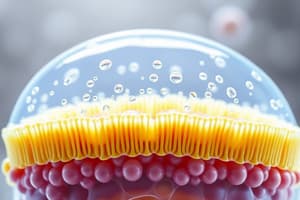Podcast
Questions and Answers
What is the fluid mosaic model of the cell membrane?
What is the fluid mosaic model of the cell membrane?
A model that describes the membrane as a mosaic of components (phospholipids, cholesterol, proteins, and carbohydrates) that allows for a fluid character.
What are the primary components of phospholipids?
What are the primary components of phospholipids?
- Two fatty acid chains
- Glycerol
- Phosphate
- All of the above (correct)
What are the characteristics of molecules that can easily pass through a phospholipid bilayer?
What are the characteristics of molecules that can easily pass through a phospholipid bilayer?
Small, nonpolar molecules can easily pass through a phospholipid bilayer.
Which factors affect membrane fluidity?
Which factors affect membrane fluidity?
Integral proteins are exclusively found on the surfaces of the membrane.
Integral proteins are exclusively found on the surfaces of the membrane.
What role do carbohydrates play in the plasma membrane?
What role do carbohydrates play in the plasma membrane?
Membranes are described as __________, meaning they allow some substances to pass while blocking others.
Membranes are described as __________, meaning they allow some substances to pass while blocking others.
What happens to an animal cell placed into a hypotonic solution?
What happens to an animal cell placed into a hypotonic solution?
How does co-transport work?
How does co-transport work?
All fatty acids in phospholipids are unsaturated.
All fatty acids in phospholipids are unsaturated.
Flashcards are hidden until you start studying
Study Notes
Plasma Membrane Structure and Function
- The plasma membrane defines the outer border of all cells and organelles.
- It manages what enters and exits the cell.
- It receives external signals and initiates cellular responses.
- It aids in adherence to neighboring cells.
- The plasma membrane is a fluid mosaic model of components.
- It is 5-10 nanometers thick.
- The fluid mosaic model was proposed in 1972.
Components
- Phospholipids are the primary component of the plasma membrane.
- Phospholipids consist of two fatty acid chains, glycerol, and a phosphate.
- Each fatty acid can be saturated or unsaturated and is amphiphilic.
- Phospholipids arrange themselves in a bilayer with polar heads facing outward and hydrophobic tails facing inward.
- Proteins are the second major component of membranes.
- Proteins serve as transporters, receptors, enzymes, or in binding and adhesion.
- Integral proteins are integrated completely into the bilayer.
- Peripheral proteins occur only on the surfaces.
- Integral membrane proteins have hydrophobic regions and hydrophilic regions.
- Peripheral proteins are permanently attached to either phospholipids or integral proteins.
- Carbohydrates are the third major component of the plasma membrane.
- They are located on the exterior surface of the plasma membrane, bound to either proteins (forming glycoproteins) or to lipids (forming glycolipids).
- Carbohydrates function in cell-cell recognition and attachment.
Membrane Fluidity
- Membrane fluidity is influenced by the type of phospholipid, temperature, and cholesterol.
- Saturated fatty acids pack together more closely than unsaturated fatty acids.
- Greater fluidity occurs with more unsaturated fatty acids.
- Cold temperatures compress molecules making membranes more rigid.
- Cholesterol acts as a fluidity buffer, keeping membranes fluid when cold but not too fluid when hot.
Membrane Asymmetry
- The inner surface of the membrane differs from the outer surface.
- Interior proteins anchor fibers of the cytoskeleton to the membrane.
- Exterior proteins bind the extracellular matrix.
- Glycoproteins bind to substances the cell needs to import.
Selective Permeability
- Membranes are selectively permeable, meaning that only certain molecules can pass through.
- The characteristics of molecules that can easily pass through a phospholipid bilayer include being small and nonpolar.
Diffusion
- Diffusion is the movement of molecules from an area of high concentration to an area of low concentration.
- Osmosis is the diffusion of water across a selectively permeable membrane.
Passive Transport
- Passive transport is the movement of molecules across a membrane that does not require energy.
- Simple diffusion is the movement of molecules across a membrane from an area of high concentration to an area of low concentration.
- Facilitated diffusion is the movement of molecules across a membrane with the help of a transport protein.
Active Transport
- Active transport is the movement of molecules across a membrane that requires energy.
- Co-transport is a type of active transport that uses the movement of one molecule down its concentration gradient to power the movement of another molecule against its concentration gradient.
Animal Cells in Solutions
- A hypotonic solution has a lower solute concentration than the cell. Water will move into the cell, causing it to swell.
- An isotonic solution has the same solute concentration as the cell. There will be no net movement of water.
- A hypertonic solution has a higher solute concentration than the cell. Water will move out of the cell, causing it to shrink.
Studying That Suits You
Use AI to generate personalized quizzes and flashcards to suit your learning preferences.




